Subsea
-
- Positive Outlook for Global Subsea Development, Deepwater Strengthening Maritime Reporter, Apr 2002 #50
There are 2,511 identified pending, probable and possible subsea production wells forecast (base case) worldwide over the next six years. Some 18 percent of these subsea completions will be installed in North America, 30 percent in Africa/Mediterranean, eight percent in Asia-Pacific, 26 percent in the North Sea and 18 percent in Brazil.
These subsea projects are in various development stages, including: 23 percent at the pending/construction stage, 11 percent bidding, 9 percent in detailed engineering, 16 percent at the front-end engineering design (FEED) stage, 16 percent of the wells probable and 26 percent possible indicating possible development in the future.
Quest Offshore estimates that there will be about 335 subsea completions installed this year worldwide growing to 364 in 2003 and 372 in 2004 (Base Case).
The Gulf of Mexico (GOM) will account for about 18 percent of this activity or 188 subsea completions over the next three years. Last year, according to Quest Offshore's survey of operators and suppliers, there were about 260 subsea trees installed globally.
Several major contract awards for subsea production trees have materialized over the last 12 months, 307 in total, which are keeping the world's five main subsea manufacturers satisfactory utilized. Including the 307 subsea trees booked last year, there are presently 571 trees pending construction for installation between 2002 and 2007, plus 302 subsea trees bidding and 219 in the detailed engineering phase. As illustrated in Figure 3, ABB, Cameron and FMC are dominant suppliers of subsea production hardware to the worldwide market followed by Kvaerner (KOP) and Dril Quip. Each of the manufacturers has strengths in specific geographical regions, however, with FMC Technologies possessing a significant majority of the market (last 12 months) in the GOM. ABB meanwhile, has a strong footing in the North Sea with a 37 percent market share (trees booked over the last 12 months) along with FMC (a very strong 32 percent) and KOP (growing at 18 percent).
With respect to the burgeoning African market for subsea trees, Cameron has a favorable market position with a 55 percent share following on the heels of several significant ExxonMobil contracts including Kizomba in Angola, Erha in Nigeria and Leased Production System (LPS). With the award of Shell's deepwater Bonga trees offshore Nigeria in early 2001, ABB will supply about 34 trees into the market or a 33 percent share of the 104 subsea trees booked for Africa during the last 12 months.
Deepwater Trends The majority (65 percent) of identified subsea wells are in deepwater. With respect to ultra-deepwater subsea production, the present share of subsea trees worldwide over 3,437 FSW (Feet Sea Water) or 1,200 MSW (meters sea water) is 39 percent. Of the remaining subsea wells forecast, 26 percent are planned for installation in 1,650-3,960 FSW (501-1,200 MSW) and 35 percent in 0-1,650 FSW (0-500 MSW).
Gulf of Mexico The GOM ranks second behind West Africa with approximately one-third of the world's estimated deepwater reserves. The great success of deepwater production in the GOM is due in part to the technological advancements and reliability of subsea production systems.
Despite declining oil & gas prices, deepwater and ultra-deepwater drilling activity in the GOM has held up reasonably well. An analysis of GOM deepwater wells drilled (> 1,000 ft.) over the last two years from January-December reveals a six percent composite increase in activity. According to the Minerals Management Service and Quest Offshore estimates, there were 116 deepwater (>1.000 ft.) wells drilled in 2001.
compared with 109 deepwater wells in 2000. This seems modest, but is quite steady compared with the measured nine percent decline in shallow water wells (under 800 ft.) over the same period.
According to Rigz.one.com. there are presently eight to nine deepwater drillships under contract in the GOM or a measured 50 percent increase over two years compared with five to six units working in 2000. The market for semisubmersibles also has held relatively steady at about 76 percent utilization with 30 to 32 semis under contract up from an average 27 units working in 2000.
Ultra-deepwater GOM drilling activity (over 3,000 FSW) experienced an extraordinary gain in 2001 with a 43 percent increase compared with 2000.
Once these discoveries are commercialized.
these projects will be candidates for stand alone subsea development schemes or mixed with dry or wet tree floating production solutions.
Statistics from Quest Offshore's Quest SUBSEA-DATA-BASE reveal a sixyear forecast for 459 subsea production wells (trees/completions) in the GOM, and Canadian Atlantic waters. This compares with a five-year average of 22 subsea trees from 1999-2000 or 53 subsea trees in 2001, a robust year.
The Market Has Strengthened Several major contract awards for subsea production equipment in 2001 have accelerated the pace of activity with 99 booked subsea trees in the GOM last year for installation during 2001 to 2005.
The North American market for subsea suppliers has grown from approximately $600 million over the last six years to an estimated $1.8 billion during the next six years. This market size denotes subsea hardware supply comprising trees, wellheads and controls and excludes costs for flowlines, umbilicals and offshore installation activities (See figure 5.).
Project Round Up Noble Affiliates' (Samedan's) Lost Ark development consists of East Breaks 420, 421, 464, 465 located in 2,750 FSW (920 MSW). which will connect to a platform 27 miles (45 km) away at East Breaks 110. Kvaerner Oilfield Products (KOP) seized the contract to supply an electro-hydraulic multiplex control system. Platform equipment includes a hydraulic power unit to generate hydraulic pressure for operating the subsea tree valves, manifold valves, and the SCSSVs; a master control station; an uninterruptible power supply; and a topside umbilical termination assembly. Subsea equipment includes a subsea umbilical termination assembly.
flying leads, and a subsea control module.
Samedan Oil inked a Letter of Intent (LOI) with Global Industries' (CHICKASAW) for its Lost Ark pipeline at East Breaks Block 421. Project workscope comprises the installation of one 26 mile, six-inch dia. rigid steel flowline. The 1,100-ton umbilical (CSO-DUCO incorporating both Super Duplex and Carbon Steel Tubes, six in total) will be tied-back to a platform at East Breaks Block 110 in 660-700 FSW including saturation diving work and the installation of a new riser at the platform.
A record setting deepwater development presently underway in the GOM is TotalFinaElf E&P USA. Inc. (TFE) Canyon Express Project. Workscope includes a single Methanol Distribution line and the deepest installed flow lines (2 @ 12-in. dia.) and Electro-hydraulic Umbilical ever, in up to 7,200 FSW.
Kvaerner Oilfield Products (KOP) is designing, manufacturing and supplying the subsea controls and a single continuous length subsea umbilical. The route length initiates from Marathon's Camden Hills prospect (MC 348) and is then routed to TFE's Aconcagua prospect (MC 305). The pipeline is linked further to BP's King's Peak development (MC 217) and finally onwards to the Canyon Station Platform at Main Pass 261 for termination on the shelf in 1,132 FSW.
Sonsub Clough Partnership's MSV MAXITA (soon to be Saipem 100 percent) is installing the primary Canyon Express 57 mile (91 km) super duplex umbilical plus over 20 km of infield umbilicals. The umbilical system will control four subsea wells at the King's Peak field, three to four subsea wells at the Aconcagua field and two subsea wells at the Camden Hills field.
Transocean Sedco Forex's drillship Discover Spirit will install and complete the - 1 0 Canyon Express subsea wells. TFE estimates completion costs at approximately $21-30 million per well.
Africa/Mediterranean West Africa is certainly a bright spot for deepwater exploration and development around the globe. It ranks first in estimated deepwater reserves with approximately a 38 percent share of deepwater reserves. West Africa also possesses the world's largest deepwater fields with an average deepwater field size ranking significantly above the rest with Brazil a distant second and the Mediterranean a close third. Quest Offshore estimates a significant 735 subsea wells forecast for Africa and the Mediterranean regions. This represents approximately 29 percent of the world market.
African Project Highlights Bonga is the first deepwater development offshore Nigeria in 3.609 FSW (1,100 MSW). The biggest contract went to AMEC in the U.K. — a $435 million contract to build the process system for the massive Bonga Floating Production Storage and Offloading (FPSO).
The fabrication and assembly of the 225,000 BOPD process deck, expected to weigh in at 17,000 tons, will be centered at AMEC's Wallsend yard on Tyneside. The FPSO hull, designed for storage capacity of 2 MBO, is being fabricated at Samsung in South Korea and is due to arrive in the U.K. during Q3 2002. Early last year, ABB seized a final $180 million contract for the sub- sea production hardware. Delivery for the equipment will begin in mid-2002 and carry on through 2009. As a result of the contract, ABB is building a $2 million subsea operations base at Onne. Shell International ordered 29 conventional deepwater trees plus the control system and five manifolds.
An added bonus for ABB is supply of the control umbilicals, subcontracted to Kvaerner, and the gas lift risers. Single Buoy Moorings (U.K.) Ltd. is executing the main contract for the mooring and installation of Shell's Bonga FPSO system.
ExxonMobil is well under way with its $3.1 billion deepwater Kizomba A development offshore Angola in up to 4,022 FSW (1,219 MSW). The development scheme for Kizomba Phase 1 incorporates a TLP plus FPSO, 32 dry production wellheads, approximately 28 Cameron spool trees to be utilized for re-injection of the gas into the reservoir, and crude export to a surface buoy.
Elsewhere offshore Angola, BP issued pre-qualification documents for the Engineering, Procurement, Installation and Commissioning (EPIC) of umbilicals, flowlines and risers for its Block 18 Greater Plutonio development offshore Angola in 1.300 MSW.
An FPSO, Spar or TLP and multiple subsea well development scheme is being evaluated for the multi-field development.
North Sea-U.K.
Quest Offshore forecasts 341 subsea wells in the United Kingdom (U.K.). As a mature province, the U.K. North Sea has become increasingly dependent on more numerous, but smaller fields where subsea developments play a large role.
U.K. Project Highlights The UK's Oil and Gas Directorate approved a further $244 million in development for Madoes and Mirren using a total of five new wells tied back through multi-phase pipelines into the existing Central North Sea Eastern Trough Area Project (ETAP) infrastructure.
Shell-operated 22/23b Madoes will be tapped with three horizontal subsea wells tied to a subsea manifold.
Multi-phase production will be exported via a 12-mile (19 km) pipeline to the Central Processing Facility within the ETAP complex, which is situated over the Marnock field. BP-operated 22/25 Mirren will use two horizontal subsea wells and export via a second subsea manifold and another multi-phase pipeline 7.5 miles (12 km) into the system.
Oil and gas from the new fields will be exported via the Forties Pipeline and Central Area Transmission Systems.
BP expects first production in early 2003.
Shell U.K. Exploration and Production is developing its Penguin field, 93 miles (150 km) northeast of the Shetland Islands, with four horizontal wells at a cost of $333 million. Successful results from these wells will result in the drilling of up to five additional horizontal wells, increasing total investment to $507 million. Penguins cluster comprises a group of five fields with reserves of oil, gas and condensate estimated at about 90 MBOE.
Call Atlantic Marine today to discuss your next repair or conversion proje, t.
North Sea-Norway The Norwegian North Sea sector comprises 311 forecast subsea wells from 2002 to 2007 or 12 percent of the worldwide total. For 2002, the Norwegian Petroleum Directorate (NPD) sees investment hitting around $5.9 billion, of which spending on production wells will comprise around half of the total, and investment in new facilities around 25 percent. The NPD anticipates a 15 percent increase in overall spending in 2003 and 2004 to an estimated $6.7 billion annually and sees average spending of $24.7 billion during 2002-2005, excluding investments in ongoing operations and exploration. Investments for the most notable development targets include the following: Statoil's $4.5 billion Snow White development, for which bids are imminent; Norsk Hydro's $2.8-3.3 billion Ormen Lange development, for which bids are expected to be called either late this year or in 2003; BP's $1.6 billion Skarv development, for which bids are expected to be called in late-2002 or 2003.
In addition, a number of smaller oil and gas fields such as Svale, Nome expansion, Skirne and Byggve are expected to be developed during 2002 to 2005.
Project Round Up Partners in Norway's Barents Sea Snohivit (Snow White) field submitted a Plan for Development and Operation (PDO) to authorities for approval, following tax concessions by the finance ministry. Workscope comprises pipelines, subsea production facilities, receiving facilities and a gas liquefaction plant.
Field development work is slated to begin in the spring of 2002, with production to be brought on stream in 2006.
Engineering. Procurement and Construction (EPC) contracts in the first phase of the $6 billion Snow White (Snohvit) LNG project are soon to be issued to fabrication contractors and subsea facilities suppliers.
Design work for a newbuild steel barge, measuring at 492 x 164 x 30 ft.
(150 x 49.9 x 9.1 m). on which the LNG plant will be built is close to completion, and a contract for the construction of the barge is likely to be awarded by the first half of 2002.
The $500 million-plus facility will accommodate up to 38,580 tons of topsides and can produce up to 203 BCF of LNG per year. Phase one of Snow White will comprise eight subsea production wells and one carbon dioxide injection well. Drilling and completion of these wells will be carried out in 2004 and 2005, with production to start in 2006.
A further eight subsea wells for Askeladden and five subsea wells for Albatross are intended for later phases.
Requests for Quotes (RFQ's) for the subsea facilities and 66 mile (106 km) 27-inch dia. export pipeline from the field are imminent with contract awards anticipated in 2002 or early 2003.
Kvaerner Oilfield Products (KOP) received a Letter of Intent (LOI) worth $ 110 million to provide equipment for ten subsea wells, production controls and support structures for the Statoiloperated Kristin field.
Workscope includes the delivery of wellheads, valve-trees and subsea production control systems for ten wells plus four, four-slot wellhead templates.
KOP in Houston will provide high-pressure components for the valve-trees, and Kvaerner in Aberdeen will build control systems.
The company will assemble the wells at its Tranby site outside Oslo, Norway.
The templates will be built at Kvaerner's yard in Egersund, Norway, where it will also undertake integration testing of the wellhead equipment.
Asia Pacific Quest Offshore forecasts 203 subsea completions during the next six years in the Asia Pacific led by 17 projects in Australia comprising 138 subsea trees and nine projects in Indonesia comprising 72 subsea wells. Woodside, Western Australia Petroleum (Wapet) and BHP Billiton are the most active operators in Australia. Woodside Petroleum plans to invest $2.54 billion in growth projects by end 2005, including the Laverda/Enfield oil project by end-2002 offshore Western Australia and the Greater Sunrise gas project in the Timor Sea.
About the Author Paul Hillegeist is President Co-Founder of Houston-bused Quest Offshore Resources, Inc. (Quest Offshore), which is a leading provider of specialized market intelligence information and consulting services to the offshore sector of the oil & gas industryworldwide.
-
- MTR100: The Norway Way Marine Technology, Jul 2014 #50
MTR contributor Eric Haun traversed the country in search of companies worthy inclusion in this year’s MTR100. He found, and presents here, a dozen. OneSubsea Announced at the end of 2012 as a joint venture between subsea systems provider Cameron and oilfield services company Schlumberger (split 60/40, respective
-
- Brazil Offshore: Petrobras & Subsea Engineering Marine Technology, Nov 2013 #34
Brazil’s Petrobras has been one of the leading players in deepwater, subsea development projects since the turn of the century. These projects include pre-salt and post-salt plays, which require extensive and complex subsea engineering and construction efforts. It would be impossible for Petrobras to
-
- Next-Generation Subsea Metrology: Better Measurements, Fast Marine Technology, Mar 2017 #52
DOF Subsea, together with subsea technology companies Sonardyne, 2G Robotics and Seatronics (an Acteon company), successfully demonstrated a new underwater surveying technique in December that could significantly shorten the time needed to map underwater structures and offshore sites. Representatives
-
- Powering the Seafloor: Put a Socket in It Marine Technology, May 2018 #22
There’s an energy revolution coming on the seabed.In efforts to boost subsea oil and gas production and reach fields further from shore, in deeper and even Arctic waters, a subsea power revolution is in progress. Several multinationals are developing systems to provide electric power across the seafloor –
-
- Advanced Subsea Marine Technology, Jan 2013 #32
At the Cutting Edge of Deepwater Studies for the O&G industry in Brazil For more than 35 years, Advanced Subsea (AS) has been deeply involved in marine technological innovation. Through steady research and partnerships with research institutes in France and Brazil, Advanced Subsea has been developing
-
- MTR100: The Ones to Watch Marine Technology, Jul 2018 #34
have made a huge impact on our day to day lives, from image recognition in Facebook to cars parking for themselves. These technologies are entering the subsea space in various shapes and forms.Paris-based Forssea Robotics is a subsea robotics and research and development (R&D) startup company, set up in 2016
-
- Subsea Vessel Ops Predicted to Grow Over Coming Years Marine Technology, Dec 2014 #30
Over the next five years Douglas-Westwood (DW) expect $122 billion (bn) to be spent on global subsea vessel operations – an increase of 64% compared to the previous five year period. This growth will be driven not only by volumes of work but also by the growing usage of higher-end vessels able to cope with
-
- Dive into Norway's Subsea Valley Marine Technology, May 2015 #38
It took three years for Subsea Valley to carve out a tradeshow and conference in a crowded market and then to proudly declare the existence of a powerful industrial grouping along the highway corridor between Kongsberg — home to the subsea juggernaut of the same name — and Oslo, the forgotten Norwegian
-
- Xodus Subsea: New Era of Subsea Engineering Support Marine Technology, Oct 2014 #56
Xodus Group, Saipem and Chiyoda join forces on new subsea company to rival largest subsea engineering firms for a share of the global market International energy consultancy Xodus Group announced the launch of a global subsea engineering company in partnership with major oil and gas contractor Saipem and
-
- Subsea Electrification: Subsea Power Evolves Marine Technology, Jan 2019 #16
As subsea power needs evolve, so to must the batteries that provide the power.Operators of autonomous underwater vehicles (AUVs) need longer survey runs, deeper dives, and lighter batteries, which result in lighter units in the water. Remotely operated vehicle (ROV) teams require electric-powered manipulators
-
- MTR100: Five "Ones to Watch" Marine Technology, Jun 2019 #34
For Marine Technology Reporter's (MTR) 14th Annual "MTR100" - a look at 100 innovators and technologies in the subsea space - MTR editor-at-large Elaine Maslin reports on five companies and technologies that are worth the watch for the remainder of 2019 and beyond. For the full edition
-
 )
March 2024 - Marine Technology Reporter page: 48
)
March 2024 - Marine Technology Reporter page: 48. . . . . . . . . . . . . . . . . . .www.birns.com . . . . . . . . . . . . . . . . . . . . . . . . . . . . . . .Please visit us online 19 . . . . .Blueprint Subsea . . . . . . . . . . . . . . . . . . . .www.blueprintsubsea.com . . . . . . . . . . . . . . . . . . . . . .+44 (0) 1539 531536 5 . . . . . .Deep Ocean
-
 )
March 2024 - Marine Technology Reporter page: 45
)
March 2024 - Marine Technology Reporter page: 45in 1969, designs and manufactures instrumentation for the oceanographic and hydrographic communities with a world- wide customer base that includes: subsea, hydrographic, metrological and positioning, oceanographic, ports, har- bours, dredging, energy and scienti? c research sectors. • Greensea IQ Signs
-
 )
March 2024 - Marine Technology Reporter page: 42
)
March 2024 - Marine Technology Reporter page: 42made a splash at Oi at the company’s Power Forward event, with the celebration of the company’s 70th anniversary, and the launch of a new high amperage subsea connector se- ries, the 225 Amp BIRNS Meridian line. The Meridian line, a robust, custom engineered dry-mate connector series is open face rated
-
 )
March 2024 - Marine Technology Reporter page: 41
)
March 2024 - Marine Technology Reporter page: 41for optimal performance. The vide a visual identi? cation of the vehicle’s surroundings. Quadroin now features a Nortek Nucleus1000 integrated subsea The newly integrated EvoLogics AI-powered object recogni- navigation package that couples Nortek’s DVL technology with tion module allows detecting
-
 )
March 2024 - Marine Technology Reporter page: 40
)
March 2024 - Marine Technology Reporter page: 40Uncrewed Surface Ves- In addition, the new USV is able to launch and recover a wide sel (USV), the DriX O-16. Bene? tting from an autonomy of range of subsea assets such as Remotely Operated Towed Ve- 2,500 Nm and a unique naval architecture that enables the USV hicles (ROTVs), inspection-class Remotely
-
 )
March 2024 - Marine Technology Reporter page: 30
)
March 2024 - Marine Technology Reporter page: 30. The physical connection and disconnection als conducted in 2022 where TMC collected 3,000 tonnes of between collector and power umbilical is performed subsea, nodules have helped further advance the design. and the LARS is ? tted with a routing system that keeps the Digital twin technology analyzes data
-
 )
March 2024 - Marine Technology Reporter page: 25
)
March 2024 - Marine Technology Reporter page: 25months after HT-HH system differed; the volcano was devoid erupted, scientists from NIWA and the of biology but features as close as 15 km Surfacing Subsea Discoveries Nippon Foundation of Japan mobilized away still had abundant life, including the Tonga Eruption Seabed Mapping Even before the recent
-
 )
March 2024 - Marine Technology Reporter page: 20
)
March 2024 - Marine Technology Reporter page: 20?8QGHUZDWHU&RPPXQLFDWLRQV ?&DEOHV &RQQHFWRUV Event Distribution: MTR E-Magazine Edition: Oceanology International, /RQGRQ8. Event Distribution: Subsea Expo Oceanographic 2?VKRUH7HFKQRORJ\&RQIHUHQFH27& $EHUGHHQ8. +RXVWRQ7;86$ Floating Wind Solutions 8'7 +RXVWRQ7;86$ /RQGRQ8. (XURSH2?VKRUH:LQG
-
 )
March 2024 - Marine Technology Reporter page: 19
)
March 2024 - Marine Technology Reporter page: 19and corrosion control cant cost savings, mainly related to vessel charter. expert having worked across The major advantage of using FiGS on any type of subsea engineering, design, modelling, structure is the large amount of accurate information obtained project management, inspection, over a relatively
-
 )
March 2024 - Marine Technology Reporter page: 16
)
March 2024 - Marine Technology Reporter page: 16the elec- odes must be regularly surveyed to determine when replace- trochemical process than the steel used in pipelines and other ments are required. subsea structures. When connected to a structure, the anodes willingly ‘sacri? ce’ themselves by corroding ? rst, effectively Survey Methods redirecting
-
 )
March 2024 - Marine Technology Reporter page: 8
)
March 2024 - Marine Technology Reporter page: 8INSIGHTS SUBSEA DEFENSE Copyright RomanenkoAlexey/AdobeStock WHEN THE SHOOTING STOPS: BLACK SEA MINE CLEARANCE WILL FEATURE ADVANCED TECH, CONOPS By David Strachan, Senior Analyst, Strikepod Systems ince the beginning of the war in Ukraine, mine warfare mines have been the weapon of choice for both
-
 )
March 2024 - Marine Technology Reporter page: 4
)
March 2024 - Marine Technology Reporter page: 4(212) 477-6700; Fax: (212) 254-6271 tional in London, perennially one Lof the world’s most important Justin Zuure CEO events serving the global subsea market. John C. O’Malley [email protected] Personally, it was my ? rst return to London for this event since 2018, as the 2020 ‘50th Anniversary’
-
 )
March 2024 - Marine Technology Reporter page: 2
)
March 2024 - Marine Technology Reporter page: 2March/April 2024 On the Cover Volume 67 • Number 3 Image courtesy NIWA-Nippon Foundation TESMaP / Rebekah Parsons-King 8 Subsea Defense Black Sea Mines When the shooting stops in the Ukraine, the tough work of clearing mines will commence. By David Strachan 12 Gliders Slocum Sentinel 22 Teledyne
-
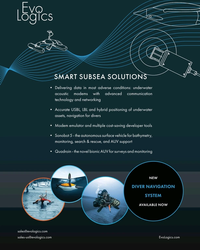 )
March 2024 - Marine Technology Reporter page: 2nd Cover
)
March 2024 - Marine Technology Reporter page: 2nd CoverSMART SUBSEA SOLUTIONS • Delivering data in most adverse conditions: underwater acoustic modems with advanced communication technology and networking • Accurate USBL, LBL and hybrid positioning of underwater assets, navigation for divers • Modem emulator and multiple cost-saving developer tools • Sonobot
-
 )
March 2024 - Marine Technology Reporter page: Cover
)
March 2024 - Marine Technology Reporter page: Cover.marinetechnologynews.com Oceanographic Instrumentation Exploring Submarine Volcanoes When the Shooting Stops Black Sea Mine Clearance Subsea Mining The Nodule Collectors Lander Lab Volume 67 Number 3 Battery Packs MarineTechnologyReporter Cover MarApr2024.indd 1 4/4/2024 1:07:18 P
-
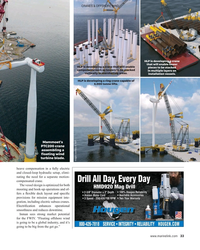 )
April 2024 - Maritime Reporter and Engineering News page: 33
)
April 2024 - Maritime Reporter and Engineering News page: 33both mooring and hook-up operations and of- fers a ? exible deck layout and speci? c provisions for mission equipment inte- gration, including electric subsea cranes. Electri? cation enhances operational smoothness and reduces downtime. Inman sees strong market potential for the FWIV. “Floating offshore
-
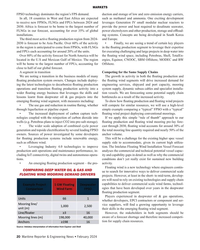 )
February 2024 - Maritime Reporter and Engineering News page: 20
)
February 2024 - Maritime Reporter and Engineering News page: 20engineering services, shipyard and port capacity, mooring operations and transition ? oating production activity into a system supply, dynamic subsea cables and specialist installa- wider ? oating energy business that leverages the skills and tion vessels. We are forecasting some potential supply
-
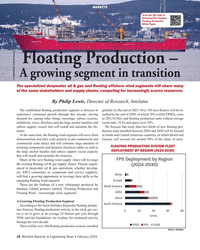 )
February 2024 - Maritime Reporter and Engineering News page: 18
)
February 2024 - Maritime Reporter and Engineering News page: 18continued growth through this decade, driving stalled by the end of 2030, of which 70% will be FPSOs, close demand for, among other things, moorings, subsea systems, to 20% FLNGs and ? oating production units without storage umbilicals, risers, ? owlines and the large anchor handlers and (semi-subs
-
 )
January 2024 - Marine Technology Reporter page: 3rd Cover
)
January 2024 - Marine Technology Reporter page: 3rd CoverSMART SUBSEA SOLUTIONS Delivering data in most adverse conditions: underwater acoustic modems with advanced communication technology and networking Accurate USBL and LBL positioning of underwater assets Modem emulator and other cost-saving developer tools Autonomous surface vehicle for bathymetry, monitoring
-
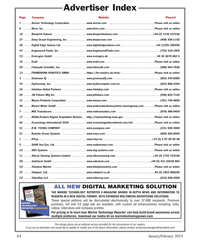 )
January 2024 - Marine Technology Reporter page: 64
)
January 2024 - Marine Technology Reporter page: 64. . . . . . . . . . . . . . . . . . .www.birns.com . . . . . . . . . . . . . . . . . . . . . . . . . . . . . . .Please visit us online 19 . . . . .Blueprint Subsea . . . . . . . . . . . . . . . . . . . .www.blueprintsubsea.com . . . . . . . . . . . . . . . . . . . . . .+44 (0) 1539 531536 27 . . . . .Deep Ocean
-
 )
January 2024 - Marine Technology Reporter page: 60
)
January 2024 - Marine Technology Reporter page: 60, meeting poten- free pH sensors for ocean monitoring; tial suppliers, hearing what’s happening in the industry – you • C-Kore Systems, simplifying subsea testing with its new learn a lot, whether you are there for one day or the whole Optical TDR unit; event. As a new committee member, I will get
-
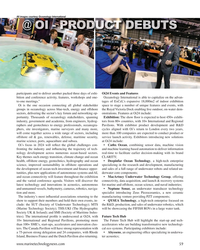 )
January 2024 - Marine Technology Reporter page: 59
)
January 2024 - Marine Technology Reporter page: 59oil & gas, renewables, defense, maritime security, service launch activity. Exhibitors introducing new solutions marine science, ports, aquaculture and subsea. at Oi24 include: Oi’s focus in 2024 will re? ect the global challenges con- • Cathx Ocean, combining sensor data, machine vision fronting the industry
-
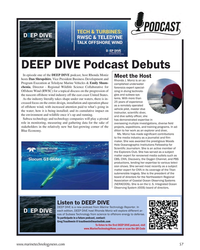 )
January 2024 - Marine Technology Reporter page: 57
)
January 2024 - Marine Technology Reporter page: 57Science Collaborative for forensics expert special- Offshore Wind (RWSC) for a topical discuss on the progression of izing in diving technolo- gies and subsea sys- the nascent offshore wind industry off the east coast United States. tems. With more than As the industry literally takes shape under our waters
-
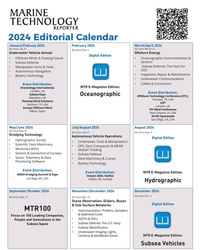 )
January 2024 - Marine Technology Reporter page: 53
)
January 2024 - Marine Technology Reporter page: 53?8QGHUZDWHU&RPPXQLFDWLRQV ?&DEOHV &RQQHFWRUV Event Distribution: MTR E-Magazine Edition: Oceanology International, /RQGRQ8. Event Distribution: Subsea Expo Oceanographic 2?VKRUH7HFKQRORJ\&RQIHUHQFH27& $EHUGHHQ8. +RXVWRQ7;86$ Floating Wind Solutions 8'7 +RXVWRQ7;86$ /RQGRQ8. (XURSH2?VKRUH:LQG
